- Agen (娃玄).
Hyōchū(標仲)’s horse. - Atsuyu (斡由).
A Gen-paku(元伯)’s name, who was at the position when Shōryū(尚隆) ascended the throne of En(雁国). - An (安).
A State. One of the Nine States(九州), En(雁国). - Black Sea (黒海 – Kok-kai).
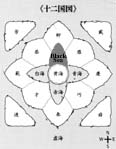
One of the four inland seas. In old customs of East Asia the color black is assigned to north and winter. So we can say the Black Sea(黒海) is the North Sea. - Blue Sea (青海 – Sei-kai).
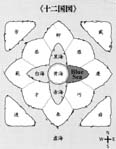
One of the four inland seas. In old customs of East Asia the color blue is assigned to east and spring. So we can say the Blue Sea(青海) is the East Sea. - boxy knapsack (笈筺 – oibako).
A boxy knapsack in my mind (by o6asan) - Brick tea.
“Brick tea” is not a kind of Japanese tea. “Brick tea” usually means all kind of Chinese block style tea. But I use “a round brick tea” as Dancha(団茶). The original story does not include this word though. In China, Dancha(団茶) is a kind of high-class tea which was a customs to Emperors in the old days. As this tea is a block, you must break down it into smaller bits by a tea knife or something before you make tea.
Dancha(団茶) in my mind (by o6asan) - Bujō (部丞).
Literally “section helper”. A position of Chikan(地官). Bujō(部丞) manages Kajō(果丞), and Kajō(果丞) manages Sekijin(迹人). - Chikan (地官).
Literally “Land Administration”. One of Rikukan(六官). - Chōsai (冢宰).
The head of Rikukan(六官), which is a prime minister, so to speak. - Chūshi (中士).
Literally “middle officer”. A rank of the national public official system. - courtesy name (字 – azana).
The courtesy name is another name to be used later in life in place of his /her given name, which is from East Asian old cultures. - Daishiba (大司馬).
The head of Kakan(夏官). - Daishito (大司徒).
The head of Chikan(地官). - Daisōhaku (大宗伯).
The head of Shunkan(春官). - En (雁州国/雁国/雁).
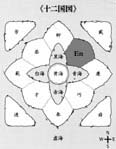
One of the Twelve Kingdoms.
It is at the northeast of the world. - En (延), Ruler.
Ruler En(延) is the Ruler(王) of En(雁国). The Ruler and the country of En have the same pronunciation, but originally the two are described by different kanjis in Japanese. - Enchō (燕朝).
An area on the Clouds where only the Ruler and high officials live. Each country has each Enchō(燕朝). - fake ruler (偽王 – giō).
The original word is “偽王”. This is not a common word and I cannot find it in Japanese dictionaries I have. So I didn’t use “impostor” because it is a common word. - Fūkan (風漢).
Shōryū(尚隆)’s courtesy name(字). - Fumin (浮民).
People that do not belong to any countries. - Gen (元).

A State. One of the Nine States(九州), En(雁国). - Gen-kō (元侯/元州侯).
Governor of the State Gen(元). Each State has a governor who is appointed to by the Ruler at the time. - Gen-paku (元伯).
A person that is the second position in the State Gen(元) Government. A State Gen ranking below a Gen-kō(元侯). - Gen’ei-kyū (玄英宮).
The palace of Ruler En(延), En(雁州国/雁国/雁). - Gisō (義倉).
Literally “public granary”. A storehouse where the local government keeps crop plants for hunger-stricken. - Gon (艮).
A county of State Sei(靖), En(雁国), which is a detached territory. - Great Gate of Northeast (令艮門 – Reigonmon).
One of the Four Great Gates, the candidates for a Ruler of kingdoms can go into the Yellow Sea(黄海) through only these Great Gates. - Gyōten (堯天).
The Capital of Kei(慶国). - Hakujō (白条).
Literally “White Lines”. It is used for a medicine, which looks like an orchid(蘭). Seijō(青条) no Ran(蘭) is named after this plant. - Hakutan (白端).
It is a town of Kei(慶国) and famous for its tea. - Hekishō (碧霄).
Hekishō(碧霄) is an imperial demesne in En(雁国). - Hisho (丕緒).
He is a Ra-shi(羅氏), Kei(慶国). - Hō (芳極国/芳国/芳).
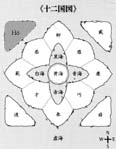
One of the Twelve Kingdoms.
It is at the northwest of the world. - Hōkō (包荒).
He is a Sanshi(山師) who was born in Seiin(西隕) which is a village of State Kei(継), En(雁国). - Hyōchū (標仲).
He is a Sekijin(迹人) who was born in Seiin(西隕) which is a village of State Kei(継), En(雁国). - Itan (帷湍).
An official of En(雁国). His post is Taisai(大宰) in the story “Hyōhaku(漂舶)”. - Ji (滋).
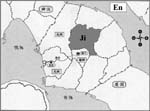
A State. One of the Nine States(九州), En(雁国). - Jichō (治朝).
An area just underneath the Clouds where the lower class officials live. Each country has each Jichō(治朝). - Jinjū-den (仁重殿).
A building of a palace, where the Kirin(麒麟) of the country usually lives at the palace. - Jinmon (人門).
A gate. - Kajō (果丞).
Literally “fruit helper”. A position of Chikan(地官). Sekijin(迹人) is one of this subordinates. - Kajō of the State (州果丞).
- Kakan (夏官).
So to speak, “Military Administration”. One of Rikukan(六官). *I’m writing to remind you that the kanji “夏” is usually used as “summer”. If you are a student in Japanese class, you should learn the meaning “summer” instead of “military” (^_^;).* - Kakan-fu (夏官府).
The Office of Kakan(夏官). - Kankyū (関弓), Mount.
Mt.Kankyū(関弓) is one of the Ryōunzan(凌雲山) of En(雁国). Mt.Kankyū(関弓) has the palace of the Ruler of En(雁) on it. - Kankyū (関弓).
The Capital of En(雁国). - Kei (慶東国/慶国/慶).
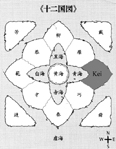
One of the Twelve Kingdoms.
It is at the east of the world. - Kei (継).
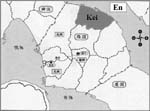
A State. One of the Nine States(九州), En(雁国). - Kirin (麒麟).
At the real world, Kirin(麒麟) is one of the old mythical creatures in East Asia and we also use the word “Kirin” as “giraffe”.
Now, I’ll write about Kirin(麒麟) in the series after this. Kirin(麒麟) is a creature beyond human knowledge. A Kirin(麒麟) selects a Ruler by a divine message and serves the Ruler until the Ruler’s death or the own death. Male Kirin(麒麟) are called Ki(麒) and female Kirin(麒麟) are called Rin(麟). - Kō (光).
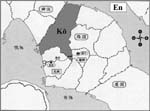
A State. One of the Nine States(九州), En(雁国). - Kongō Mountains (金剛山).
Kongō Mountains(金剛山) is the Great Barrier Wall Mountains which surround the Yellow Sea(黄海). - Kōya (更夜).
A child raised by a Yōma(妖魔). The chance that this happens is close to zero. - Kyō (恭州国/恭国/恭).
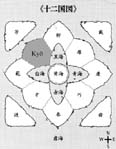
One of the Twelve Kingdoms.
It is at the northwest of the world. - Kyō (梟), Ruler.
One of Rulers En(延), the previous Ruler(王) of En(雁国). Kyō(梟) is his posthumous name. The kanji “梟” means “owl”. An owl is an owl. But 梟 has a bad meaning as a posthumous name for a Ruler. - Kyōkei (興慶).
He is a Ryōboku-shi(猟木師) that is one of Fumin(浮民). - Northeast Seagate (艮海門 – Gonkaimon).
One of the Four Seagates. It is the division of the Black Sea(黒海) and the Blue Sea(青海). Though it is at the southwest of the State Tei(貞), En(雁), it is called the “Northeast” Seagate because it is at the northeast of the Yellow Sea(黄海). The Kanji “艮” means “northwest”. In old customs of East Asia the color black is assigned to north and winter and the color blue is assigned to east and spring. So we can say the Black Sea(黒海) is the North Sea and the Blue Sea(青海) is the East Sea. - official ribbon (綬 – ju).
An identification of the official like a police badge. - ranka (卵果).
Literally “Egg fruit”. In the Twelve Kingdoms world all creatures, i.e. humans, animals, plants and so on, grow in an egg-like shell on village trees or yaboku(野木). - Red Sea (赤海 – Seki-kai).
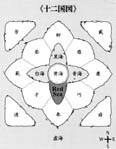
One of the four inland seas. In old customs of East Asia the color red is assigned to south and summer. So we can say the Red Sea(赤海) is the South Sea. - Reiin (令尹).
A prime minister of a State. An extra position. - Rifu (里府).
Villages Agency or its branch. - Rikukan (六官).
The government. Literally “Six Administrations”. Tenkan(天官), Chikan(地官), Shunkan(春官), Kakan(夏官), Shūkan(秋官) and Tōkan(冬官) are subordinates to Rikukan(六官).
I think Ono sensei borrows a lot of terms and administrative organs from the ancient Chinese book Shurai(周礼) which was written in Shunjū(春秋) era(= 772 BC – 476 BC). Shurai is a lumping of legal documents. - Rikukan-fu (六官府).
The Office of Rikukan(六官). - Roboku (路木).
Each country has each Roboku(路木) in its Ruler’s palace. All village trees(里木) in the country are grown from cuttings of the Roboku(路木). - roka (廬家).
A house for farm work which a family usually lives in from spring to autumn. - Rokuta (六太).
The Enki(延麒) of Shōryū(尚隆), Ruler En(延). He is a Taika(胎果), so, Rokuta(六太) is a name given by his parents of Hōrai(蓬莱 ≒ Japan). - Ruler’s Army (禁軍 – Kingun).
A Ruler’s Army(禁軍) is made of three divisions formally, called a left division(左軍 – Sagun), a middle division(中軍 – Chūgun) and a right division(右軍 – Yūgun). Each division has 12,500 soldiers by rule. But it often doesn’t have enough soldiers because of lacking of national capability. - Ryōboku-shi (猟木師).
Literally “person that hunts trees”. A person looks for useful fruits from yaboku(野木) and grows the plants and makes his living by them. - Ryosho (閭胥).
Literally “village official”. A person who is the lord of the village home(里家 – rika), the principal of the village school(小学 – Shōgaku), and so on. - Ryōunzan (凌雲山).
Unique mountains in the Twelve Kingdoms world. They are high enough to reach the sky and each has a palace or a residence on it. - Saiho (宰輔).
The position of Kirin(麒麟) at the government. - Sankō (三公).
Literally “three dukes”. It is a term used to refer to Taishi(太師), Taifu(太傅) and Taiho(太保). - Sanshi (山師).
Literally “mountain master”. A position of Kakan(夏官). *I’m writing to remind you that we usually read the word “山師” “yamashi”. The “yamashi” means a mountebank or something. If you are a student in Japanese class, you should learn the word “yamashi” instead of “sanshi” (^_^;).* - San’yō (讃容).
A town of En(雁国). - Sei (靖).
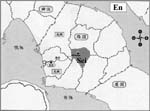
A State. One of the Nine States(九州), En(雁国), which includes the capital Kankyū(関弓). - Seiin (西隕).
A village of State Kei(継), En(雁国). - Seijō (青条).
Literally “Blue Lines”. It looks like an orchid(蘭) and has pure blue(青) color petals. - Sekichō-shi (射鳥氏).
A position of Kakan(夏官). 射鳥 literally means “shooting birds”. - Sekichō-shi-fu (射鳥氏府).
The Office of Sekichō-shi(射鳥氏). - Sekijin (迹人).
Literally “tracer”. A position of Chikan(地官). - Sekka (節下).
A prefecture of State Kei(継), En(雁国), which includes Seiin(西隕). - Sen (仙).
A person who has Senseki(仙籍), is ageless and almost immortal. - Senseki (仙籍).
Ageless and Immortal registration. - Seishō (成笙).
An official of En(雁国). His post is Daishiba(大司馬) in the story “Hyōhaku(漂舶)”. - Shiba (司馬).
Literally “controlling horses”. A full general, so to speak. The head of Kakan(夏官) is called Daishiba(大司馬). - Shirei (使令).
A Yōma(妖魔) who had a contract with a Kirin(麒麟). The Yōma(妖魔) serves the Kirin(麒麟) until the Kirin’s death, then eats the body to get the Kirin’s ability. - Shitsudō (失道).
The only disease of Kirin(麒麟) who becomes this by the Ruler’s misadministration. - Shō (霄), Mount.
Mt.Shō(霄山) is at Hekishō(碧霄), one of the Ryōunzan(凌雲山) in En(雁国). - Shōfu (少府).
Literally “smaller prefect”. A position of Chikan(地官). Shōfu(少府) manages Bujō(部丞), Bujō(部丞) manages Kajō(果丞), and Kajō(果丞) manages Sekijin(迹人). *I’m writing to remind you that the kanji “少” is usually used as “less”. If you are a student in Japanese class, you should learn “小” as “small” instead of “少” (^_^;).* - Shōfu of the State (州少府).
- Shōgyoku (湘玉).
A woman’s name who lives in Hekishō(碧霄), En(雁国). - Shōko (掌固).
Literally “guard”. A position of Kakan(夏官). Sanshi(山師) is one of this subordinates. - Shōryū (尚隆).
Ruler En(延). He is a Taika(胎果), and his full name is Komatsu Saburō Naotaka(小松三郎尚隆) in Hōrai(蓬莱 ≒ Japan). The master of Rokuta(六太). - Shōshito (小司徒).
Shōshito (小司徒) assists Shūshito(州司徒) in a State government and does Daishito(大司徒) in the national government. So to speak, a “deputy” of Shūshito(州司徒) or Daishito(大司徒). - Shujō (主上).
The title for Ruler, i.e. Your Majesty, His/Her Majesty. - Shūkan (秋官).
So to speak, “Judicial Administration”. One of Rikukan(六官). *I’m writing to remind you that the kanji “秋” is usually used as “autumn”. If you are a student in Japanese class, you should learn the meaning “autumn” instead of “Judicial” (^_^;).* - Shukō (朱衡).
An official of En(雁国). His post is Daisōhaku(大宗伯) in the story “Hyōhaku(漂舶)”. - Shūkō (州侯).
Governor of a State. Governors are appointed to by the Ruler at the time. - Shunkan (春官).
So to speak, “Protocol Administration”. One of Rikukan(六官). *I’m writing to remind you that the kanji “春” is usually used as “spring”. If you are a student in Japanese class, you should learn the meaning “spring” instead of “protocol” (^_^;).* - Shūshito (州司徒).
State head of Chikan(地官). Each State has a Shūshito(州司徒). - Sō (奏南国/奏国/奏).
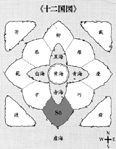
One of the Twelve Kingdoms.
It is at the south of the world. - Sō (宗), Ruler.
Ruler Sō(宗) is the Ruler(王) of Sō(奏国). The Ruler and the country of Sō have the same pronunciation, but originally the two are described by different kanjis in Japanese. - sūgu (騶虞).
A Yōjū(妖獣) that resembles a tiger. - Suiryō (遂良).
He is a Sekichō-shi(射鳥氏), Kei(慶国). - Taigen (大元).
One of the era names at the reign of Shōryū (尚隆), En(雁州国/雁国/雁). - Taiho (台輔).
The title for Kirin(麒麟). - Taika (胎果).
A person was born in Hōrai(蓬莱 ≒ Japan)/Konron(崑崙 ≒ China) though the person originally belongs to the Twelve Kingdom world. - Taisai (大宰).
The head of Tenkan(天官). - Tama (たま).
A sūgu(騶虞)’s name. The sūgu(騶虞) that for Shōryū(尚隆)’s riding. - Teaware (茶器 – Chaki).
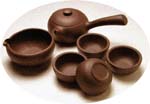
A Chinese teaware set for four people. - Tei (貞).
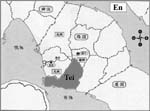
A State. One of the Nine States(九州), En(雁国). - Tenkan (天官).
Literally “Heaven Administration”. It rules everything of the court. One of Rikukan(六官). - Tenkan-fu (天官府).
The Office of Tenkan(天官). - Tōkan (冬官).
So to speak, “Produces and Stores Administration”. One of Rikukan(六官). *I’m writing to remind you that the kanji “冬” is usually used as “winter”. If you are a student in Japanese class, you should learn the meaning “winter” instead of “produces and stores” (^_^;).* - Tōkan-fu (冬官府).
The Office of Tōkan(冬官). - Tora (とら).
A sūgu(騶虞)’s name. The sūgu(騶虞) that for Rokuta(六太)’s riding. - Tōshaku (陶鵲).
Literally “ceramic magpie”. They are a kind of targets for arrows, have shapes of birds, and are used at the shooting-arrow ceremonies (射儀). - village home (里家 – rika).
A kind of community center in the village. It is used as orphanage, retirement home, and so on. - village (里 – machi).
Literally “village”. Actually, in the Twelve Kingdoms series, Ono Sensei gives the furigana まち to 里. まち is usually translated to town in English. But, according to her writing, 里 is usually made from 25 houses only. So I(=o6asan) think “village” as its translation is better. - village shrine (里祠 – rishi).
A shrine which enshrines a village tree(里木 – riboku). - village tree (里木 – riboku).
The tree in a village shrine which bears a ranka(卵果) if a married couple wishes for a child. - White Sea (白海 – Hak-kai).
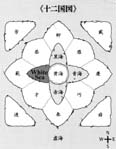
One of the four inland seas. In old customs of East Asia the color white is assigned to west and autumn. So we can say the White Sea(白海) is the West Sea. - writing brush (筆 – fude).

Writing brushes of various sizes. - yaboku (野木).
Literally “wild tree” which bears ranka(卵果) of wildlife or vegetation. - Yellow Sea (黄海 – Kō-kai).
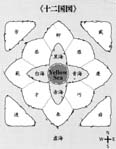
The area includes Mt.Hō(蓬), the birthplace of Kirin(麒麟). It is named “sea”, but it is not a real sea. - Yo (予), Ruler.
One of Rulers Kei(景), the previous Ruler(王) of Kei(慶国). Her name is Jo Kaku(舒覚). Yo(予) is her posthumous name. - Yōjū (妖獣).
Literally “strange and weird animal”. Creatures people tame and use as riding animals. - Yōma (妖魔).
Literally “strange and weird demon”. A creature beyond human knowledge. Some Yōma(妖魔) make a contract with a Kirin(麒麟) and the Yōma(妖魔) serves the Kirin(麒麟) until the Kirin’s death. - Yosei (予青).
Ruler Yo(予)’s era name, Kei(慶東国/慶国/慶). - Yosen (余箭).
A mid-sized post town of En(雁国).